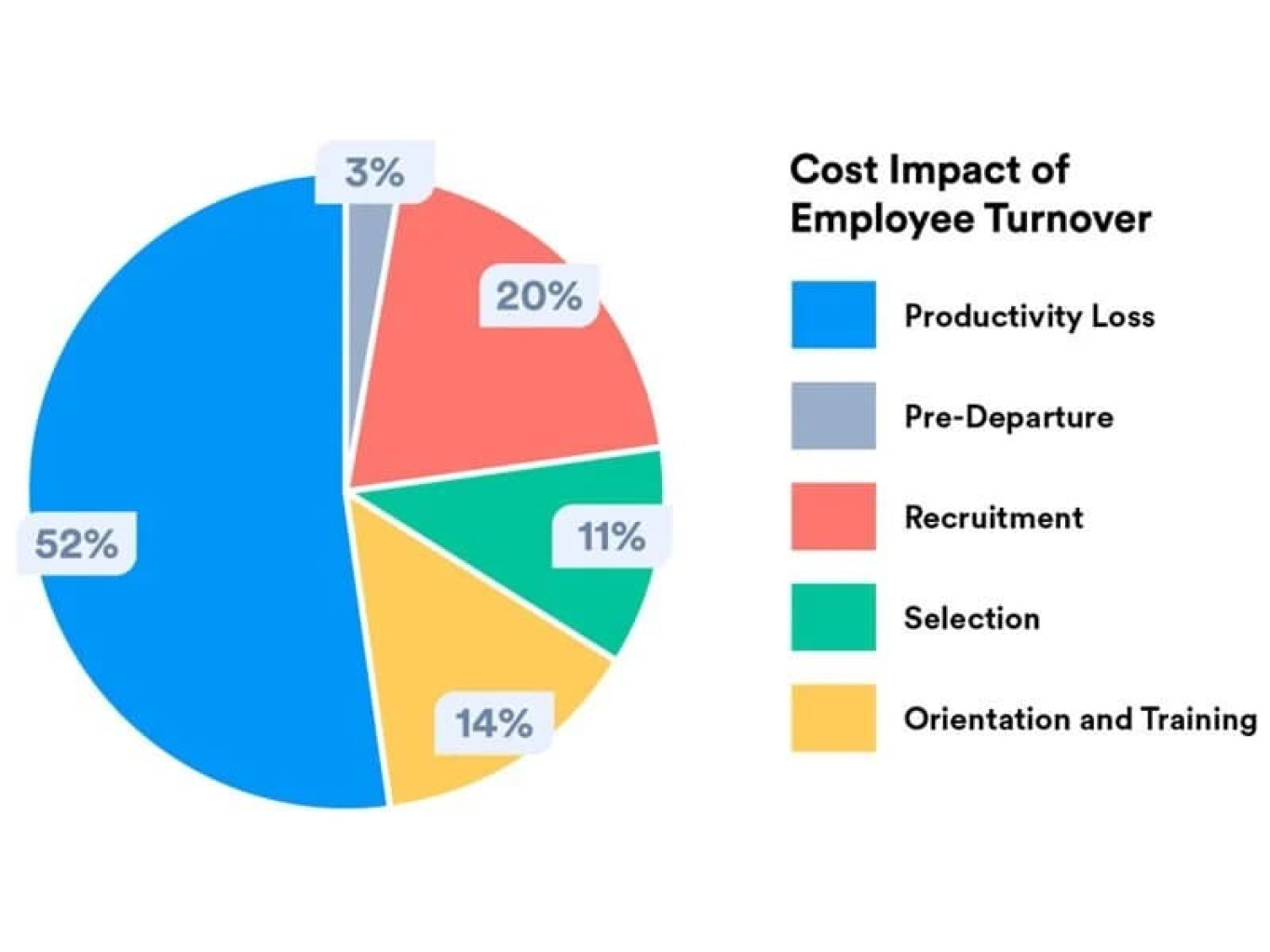- The Hidden Costs of Employee Turnover
- Career Stagnation: A Major Reason Why Employees Quit
- How Compensation Affects Employee Retention
- The Role of Work-Life Balance in Preventing Employee Resignations
- Burnout: The Silent Contributor to Employee Attrition
- Strategies to Reduce High Employee Turnover Rates
- Conclusion
Employee turnover is a big challenge that can hurt a business in many ways. Losing employees costs money, disrupts teams, and weakens company culture. To keep your best people, it's important to understand why they leave in the first place.
There are many reasons employees quit, like feeling stuck in their jobs, not being paid enough, or struggling with work-life balance. By tackling these issues head-on, businesses can build a stronger, more loyal team. This helps reduce turnover and creates a workplace where employees want to stay.
The Hidden Costs of Employee Turnover
High employee turnover comes with costs that businesses often underestimate. Losing talent is just the start—turnover can weaken the entire business. According to the Society for Human Resource Management (SHRM), replacing an employee can cost 50-60% of their yearly salary, factoring in recruitment, training, and the drop in productivity during the transition.

Direct Financial Impact on Businesses
Employee turnover isn’t just about finding a replacement—it has deeper financial implications that can affect a company in multiple ways. Beyond the obvious costs of recruiting and training, turnover can disrupt operations, decrease morale, and strain resources. These impacts can accumulate, creating a significant financial burden that goes unnoticed until it’s too late:
- Decreased productivity during the hiring and training process, as existing employees juggle their duties while getting the new hire up to speed.
- Loss of valuable knowledge and skills when experienced staff leave, leading to gaps that can disrupt operations and require additional training.
- Increased workload on remaining employees, which can cause burnout and potentially lead to even more turnover.
- Disruption in team dynamics and morale, as constant changes can affect cohesion and collaboration.
The Cost of Recruiting and Training New Hires
Bringing new employees on board is a resource-intensive process that goes far beyond just filling a vacancy. The financial strain can be considerable, especially for high-skill positions where finding the right candidate is crucial. A 2018 study by Gallup estimated that replacing an employee can cost anywhere from half to two times their annual salary, depending on the role. These costs include:
- Advertising the open position across various platforms to attract suitable candidates.
- Screening and interviewing candidates, which demands significant time from HR and department heads.
- Background checks and reference verification, ensuring the candidate’s qualifications and fit for the role.
- Training new hires to reach full productivity, which often involves mentoring, formal training sessions, and onboarding programs.
- Loss of productivity during the transition period, as new hires take time to adjust and get up to speed.
- Increased workload on existing employees during the vacancy and training period, which can lead to temporary declines in performance and morale.
These costs can add up quickly, making employee retention a critical strategy for maintaining financial health and operational stability.
Operational Inefficiencies Caused by High Turnover
High turnover disrupts daily operations in ways that aren’t always immediately visible. When employees frequently leave, the constant cycle of hiring and training can slow down overall productivity, causing delays in project timelines and reducing the quality of work. These disruptions often lead to inconsistent customer service and missed opportunities, which can damage a company's reputation over time.
Moreover, high turnover undermines team cohesion and collaboration. As team members come and go, it becomes difficult to maintain a strong, unified work culture, leading to fragmented communication and less effective teamwork. Over time, these inefficiencies can compound, making it harder for the business to achieve long-term goals and maintain a competitive edge.
Career Stagnation: A Major Reason Why Employees Quit
When employees feel stuck in their roles without a clear path to advance, they often look for better opportunities elsewhere. Career stagnation is a key reason why people leave their jobs.

LinkedIn research shows that the lack of career advancement is the top reason employees quit. Providing clear growth opportunities and career paths is essential for keeping employees engaged and motivated. Regular feedback and personalized development plans can help employees see their future within the company, making them more likely to stay.
The Importance of Career Development Opportunities
Career development is crucial for keeping employees satisfied and committed to their roles. When companies offer growth opportunities, they not only boost morale but also significantly reduce turnover rates.
Providing regular training and development programs keeps employees engaged and motivated. It also ensures that they are continuously improving their skills and contributing to the company’s success. Moreover, employees who see a clear path for advancement are more likely to remain loyal, knowing their efforts are recognized and rewarded.
Employee Perceptions of Career Progression
Employees are more likely to stay with a company when they see a clear and attainable path for advancement. Career progression isn't just about promotions; it's about how employees envision their future within the organization. When they see opportunities for growth, they feel more secure, valued, and motivated to contribute to the company’s success.
How employees perceive their career progression plays a crucial role in retention. To foster this:
- Clearly communicate potential career paths and growth opportunities.
- Conduct regular performance reviews to discuss progress and next steps.
- Establish transparent promotion criteria to ensure fairness and trust.
- Provide mentorship or coaching programs to guide employees in their career development.
When employees understand how they can advance within the company and have support along the way, they are more likely to feel secure and committed to their roles.
Offering Lateral Moves as an Alternative to Vertical Growth
Not every employee is driven by the desire to climb the corporate ladder. Providing opportunities for lateral moves can be a valuable way to keep employees engaged and motivated. These moves allow employees to explore different roles and take on new challenges, which can refresh their enthusiasm and help them develop a broader skill set.

By offering lateral moves, you enable employees to gain diverse experiences and stay invested in their roles without the pressure of traditional upward advancement. This approach not only helps in retaining talent but also reduces the risk of burnout by keeping the work experience dynamic and fulfilling.
How Compensation Affects Employee Retention
Compensation is a crucial factor in employee retention, influencing whether staff choose to stay with or leave a company. While it's not the sole reason employees stay, competitive salaries and benefits are often top considerations when they evaluate their job satisfaction and future with the company.
Offering attractive salaries is essential for drawing and keeping top talent, but it's equally important to provide a comprehensive compensation package. This includes not just competitive pay but also bonuses, health benefits, and retirement plans. A well-rounded package helps employees feel valued and secure, which can enhance their commitment to the organization.
The Role of Competitive Salaries in Retention
Competitive salaries are fundamental to retaining employees, as they meet the baseline expectations for compensation. Aligning salaries with industry standards is crucial to attracting and keeping top talent.
Conducting regular salary reviews ensures that employees are fairly compensated for their contributions, which helps maintain job satisfaction. Fair pay practices not only boost morale but also reduce the likelihood of turnover by showing employees that their efforts are recognized and valued.
Understanding Employee Expectations Around Compensation
Grasping what employees expect from their compensation packages is crucial for preventing dissatisfaction and reducing turnover. Employees are more engaged and loyal when they feel their compensation is fair and meets their needs. Ensuring that compensation aligns with their expectations helps build trust and commitment to the company.
To effectively manage these expectations, consider the following strategies:
- Maintain transparent communication about salary and benefits to ensure clarity and trust.
- Regularly benchmark salaries against industry standards to stay competitive.
- Offer opportunities for salary increases based on performance to reward and motivate employees.
- Provide comprehensive benefits packages, including health insurance and retirement plans, to address broader financial and personal needs.
- Solicit employee feedback on compensation to understand their needs and adjust offerings accordingly.
By aligning compensation with employee expectations and industry norms, you can create a more satisfied and committed workforce.
Balancing Financial Rewards with Non-Monetary Recognition
Balancing financial rewards with non-monetary recognition is essential for a well-rounded approach to employee motivation and retention. While competitive salaries and bonuses are important, recognizing employees through non-monetary means can also significantly impact their job satisfaction. Public acknowledgment, meaningful praise, and opportunities for professional development can enhance employees' sense of value and belonging.
Non-monetary recognition complements financial rewards by fostering a positive work environment and reinforcing desired behaviors. Implementing recognition programs, such as employee of the month awards or special shout-outs in meetings, can boost morale and encourage long-term commitment. This balanced approach helps create a more engaging and supportive workplace where employees feel appreciated both financially and personally.
The Role of Work-Life Balance in Preventing Employee Resignations
Work-life balance has become a crucial factor for employees in today’s work environment. When employees struggle to balance their work and personal lives, it can lead to burnout, dissatisfaction, and eventually, resignation.

A survey by the American Psychological Association highlights that employees who feel their employer supports work-life balance are more likely to stick around. This shows how essential it is to foster a work environment that respects and supports employees' personal lives, contributing to their overall job satisfaction and loyalty.
Creating a Company Culture that Values Work-Life Balance
A company culture that prioritizes work-life balance is essential for retaining employees and enhancing overall job satisfaction and productivity. When companies actively support their employees' personal lives, it fosters a positive work environment that encourages long-term commitment.
Here are key ways to build such a culture:
- Encourage employees to take their full vacation days: Promote time off as a way to recharge and prevent burnout.
- Offer flexible work hours: Allow for adjustments to accommodate personal responsibilities and different work styles.
- Promote work-life balance through company policies: Implement guidelines that support flexibility, such as remote work options and family leave.
Real-Life Example: Google exemplifies this approach by providing a flexible work environment, including remote work options, which has led to high employee satisfaction and retention rates. Embracing these practices helps create a supportive and engaging workplace where employees feel valued both professionally and personally.
How Flexible Work Arrangements Improve Retention
Flexible work arrangements have become a major factor in retaining employees. They offer a way for team members to better balance their work and personal lives, which can lead to increased job satisfaction and loyalty.
Options like remote work and flexible hours can make a big difference in whether employees choose to stay with a company. These arrangements not only boost morale but also help create a more supportive and adaptive work environment.
The Growing Importance of Remote Work Options
Remote work has shifted from being a mere perk to a crucial necessity for many employees. As more people seek flexibility and better work-life balance, companies offering remote options have a competitive edge in retaining top talent.
Research by Owl Labs reveals that remote workers are 13% more likely to remain with their current employer compared to those working on-site. This highlights the significant role that remote work can play in boosting employee retention and satisfaction.
The Link Between Work-Life Balance and Mental Health
Work-life balance and mental health are closely intertwined. A poor balance can lead to heightened stress, anxiety, and eventually burnout, affecting both well-being and productivity.
Research from the American Psychological Association found that employees who perceive their employer as supportive of work-life balance are 30% more likely to report lower stress levels and higher job satisfaction. To promote mental health, companies should offer resources and support, encourage regular breaks, and create an environment that prioritizes well-being. Implementing these practices can significantly enhance employee morale and overall productivity.
Burnout: The Silent Contributor to Employee Attrition
Burnout is a significant yet often overlooked factor in employee attrition. It gradually erodes employee well-being and productivity, leading to higher turnover rates. Addressing burnout is crucial for maintaining a stable and motivated workforce.

Recognizing the Early Signs of Employee Burnout
Identifying burnout early is crucial for maintaining a healthy and productive workforce. By recognizing the signs of burnout, you can intervene before the situation worsens, preventing long-term damage to both employees and the organization. Early action helps keep your team engaged and can improve overall job satisfaction.
- Decreased productivity and engagement: When employees show a noticeable drop in their work output and enthusiasm, it may indicate burnout.
- Increased absenteeism or lateness: A rise in frequent absences or tardiness can be a sign that an employee is struggling with their workload.
- Emotional exhaustion or detachment from work: Feeling emotionally drained or disconnected from job responsibilities often points to burnout.
Addressing these signs proactively can help mitigate burnout's impact, preserving employee well-being and sustaining a positive work environment. Taking steps to support your team before burnout sets in fosters a more resilient and motivated workforce.
The Role of Workload Management in Preventing Burnout
Effectively managing workloads is crucial for preventing burnout and ensuring sustained employee performance. Research from the University of California, Irvine, highlights that excessive workload, especially in remote settings, can significantly reduce productivity. The study found that employees who experienced increased workload showed a 30% decline in performance due to heightened stress and diminished focus.
To address these challenges, companies should regularly assess and adjust employee workloads to avoid overwhelming their staff. Proper workload management has been shown to enhance employee well-being and performance, ultimately leading to lower turnover rates and a more effective work environment. By taking a proactive approach, businesses can support their employees and maintain high productivity levels.
Satya Nadella, CEO of Microsoft:"The key to achieving a better work-life balance is not to eliminate work, but to make sure that we are creating the right conditions for our employees to thrive. This means understanding and managing workloads effectively."
How to Help Employees Recover from Burnout
Supporting employees through burnout recovery is not just about retaining talent—it's about fostering a workplace that values mental well-being and long-term success. When employees feel supported during challenging times, they are more likely to remain engaged and loyal, ultimately contributing to a healthier, more productive work environment. Addressing burnout requires a proactive approach that includes practical measures and a commitment to employee care.
- Offering mental health days or reduced workloads: Providing time off or lighter duties helps employees recharge and avoid further burnout.
- Providing access to counseling or support services: Ensuring that employees have access to professional help, such as counseling or mental health resources, is essential for effective recovery.
- Encouraging open communication about workload and stress levels: Fostering an open dialogue about stress and workload allows employees to express their concerns and receive timely support.
- Implementing flexible work arrangements: Allowing remote work or flexible hours can alleviate stress and give employees the space they need to recover.
- Regular check-ins with managers: Frequent, supportive conversations help managers identify early signs of ongoing stress and adjust workloads or offer additional resources.
By taking these steps, companies can create a culture of support and understanding that not only aids in burnout recovery but also strengthens the overall resilience of the workforce. A focus on mental health and well-being can lead to sustained employee satisfaction and long-term organizational success.
Strategies to Reduce High Employee Turnover Rates
Reducing high employee turnover demands a thoughtful, multifaceted approach. It's about identifying and tackling the various factors that lead to dissatisfaction and disengagement. By focusing on the root causes, companies can create a more stable and committed workforce.
Enhancing Communication Between Management and Employees
Strengthening communication between management and employees is key to retaining talent. When management maintains open and honest communication, employees feel more valued and engaged in their work. Regular feedback sessions create opportunities for dialogue and ensure that employees' voices are heard.
Open-door policies further encourage a transparent environment where concerns can be addressed promptly. Fostering a culture of active listening and quick response to issues can significantly reduce turnover, improving overall morale and job satisfaction.
Creating a Robust Employee Retention Plan
A strong employee retention plan is crucial for maintaining a motivated and engaged workforce. It goes beyond simple incentives, focusing on a holistic approach that addresses various aspects of job satisfaction. By understanding the needs and expectations of employees, companies can develop a strategy that not only reduces turnover but also fosters a positive work environment.
- Conducting regular employee satisfaction surveys.
- Offering tailored development and growth opportunities.
- Providing competitive compensation and benefits packages.
Conclusion
To effectively tackle employee turnover, it's crucial to address its hidden costs and underlying causes. By understanding the financial and operational impacts of high turnover, businesses can implement strategies to mitigate these issues. Investing in career development, competitive compensation, and work-life balance initiatives not only boosts employee satisfaction but also enhances retention.
Ultimately, creating a supportive and engaging work environment is key to reducing turnover and fostering long-term loyalty. By focusing on these strategies, companies can build a stronger, more resilient team that drives success and stability.
- Identify and address the root causes of employee dissatisfaction.
- Invest in career development, competitive compensation, and work-life balance.
- Foster a supportive and engaging work environment to improve retention.


 Posted on Sep 3, 2024 by Brainy HR
Posted on Sep 3, 2024 by Brainy HR


